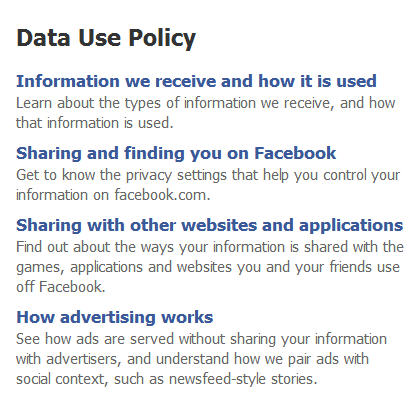Understanding Facebook’s New Privacy Policy
Facebook has made some changes to what it calls its “data use policy,” which is essentially the same as its privacy policy. The company has also added a “Facebook Terms and Policies” hub that serves as a central landing page for all of Facebook’s policies, including a link to its Data Use Policy. Facebook also published an “Explanation of changes,” and posted a track changes document that shows the changes with additions and deleted text highlighted in red. The company’s data use policy document has little light bulbs to highlight important points that it thinks people need to pay attention to.
Most of the changes are fairly minor and some are designed to provide extra information per an agreement between Facebook and the Irish Data Protection Commission.
For example, the company added language that states exactly what information about users is always made public such as name, profile picture and cover photo, networks you’re part of and your user name and ID. It also says that “your age range, locale (or language) and gender can also be made public. Some of that public information, such as your profile picture, can be deleted from your timeline.”
Showing ads on other sites
The company previously stated it we might place ads on other sites but clarified that those those “may or may not include social context (such as whether your friends have “liked” a particular business).” What this means is that it’s possible that if you “Like” something on Facebook that information could appear in an ad on another site, just as it can now appear on Facebook. It’s important to know that clicking a “Like” button is making a public statement.
The company clarified that it can retain data about you “for as long as necessary to provide services to users and others,” and that inlcudes information from advertisers.
In its explanation on data use, the company makes it clear that you can control the audience for everything you post on the service, each time you post.
There is also a clear explanation of what data Facebook recives about its users. This includes every time you look at another person’s profile, send a message, search for a friend or click on an ad. They also can receive metadata associated with what up upload such as the time and location of where a photo was taken. And, of course, they receive data from the device you’re using such as your IP address or your GPS coordinates from a mobile device.
Facebook acknowledged that it sometimes gets data from advertising partners, customers and other third parties “that helps us (or them) deliver ads.
Apps and third party websites
The company now says that “If an app wants additional information, they must get your permission. If you do this, the app can access, store and update that information,” but “Once you haven’t used the app for a while, however, that app won’t be able to continue updating this additional information until you give it permission again.” But they have added a tip ” to remind you that apps have their own policies around how they handle the data they receive and that you should contact an app directly if you want your information deleted.”
Facebook says that when you use the “login with Facebook” option in apps or other sites that it will “scramble your email address and then instruct the other website to scramble it in the same way.” That allows Facebook to identify it’s you without having to send your email address to the other site.

Targeted ads but not shared information
Facebook says that it doesn’t share information with advertisers but it does target ads based on who you are. So, you could see an ad that’s targeted to your gender, age-range, where you live or even who your friends are but Facebook is delivering that ad — the advertiser is not given that information.
What you let them share
Facebook, its advertisers and its app developers may share information about you if you allow them to through permissions that you’re asked to check when you install apps which is why it’s important to pay attention to those permissions and know how to change them which you can do from the Ads, Apps and Websites section of your Privacy Settings page.
For more, see this on News.com, this AP story and this on TechCrunch.
Disclosure: I’m co-director of ConnectSafely.org, a non-profit Internet safety organization that receives financial support from Facebook.

Leave a comment
You must be logged in to post a comment.